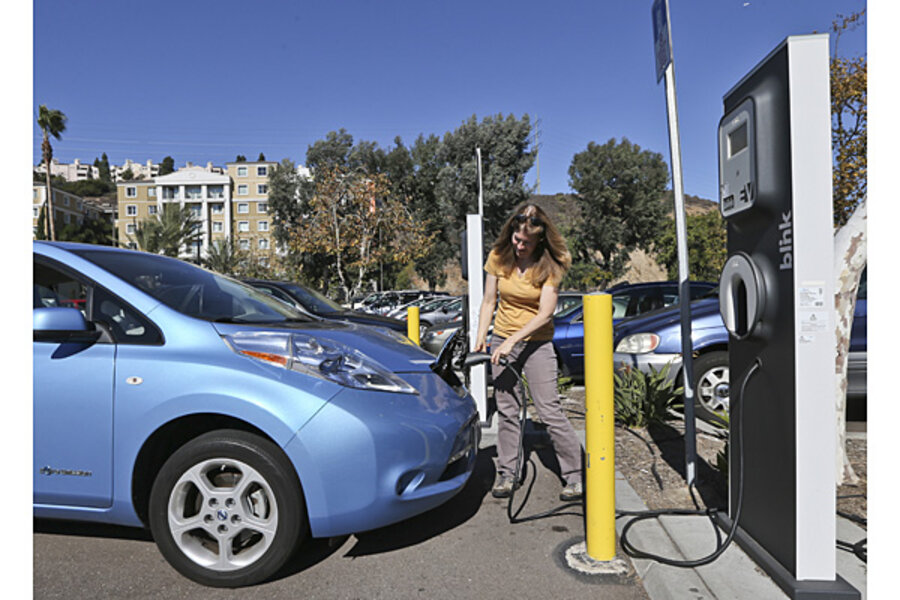Five myths about green cars and gas mileage
Loading...
Every now and then we get a reader question that reminds us how many myths about green carsare out there.
In the interests of helping you actually save money by using less gasoline, here are five of our favorites--with explanations as to why they're myths.
(1) Boosting gas mileage from 33 to 50 mpg saves more gasoline than replacing a 10-mpg vehicle with one that does 20 mpg.
As we explained three years ago in an article that still circulates, that simply isn't true.
If you replace an old pickup that gets 10 mpg with a new one that gets 20 mpg, you cut your gasoline consumption every 100 miles from 10 gallons to 5--saving you 5 gallons.
But if you swap your old 33-mpg economy car for a new 2014 Toyota Prius (rated at 50 mpg), that only saves 1 single gallon over the same distance--down from 3 to 2 gallons.
Boosting the gas mileage of the lowest-efficiency vehicles displaces a lot more gas than taking a high-efficiency vehicle higher. We suggest you do both, of course.
DON'T MISS: Which Is Greener: Flying Or Driving To Your Destination?
(2) Electric cars "burn coal," so they pollute just as much as gasoline cars.
Again, untrue. Electric cars use energy far more efficiently than cars with combustion engines.
Granted, electric grids vary widely in the carbon they emit per kilowatt-hour.
But a study last year by the Union of Concerned Scientists showed that an electric car running on the dirtiest grid in the country (ND or WV, for the record) has a wells-to-wheels carbon footprint almost equivalent to the best non-hybrid gasoline car, about 35 mpg.
On cleaner grids--including those in California, which will buy more plug-in electric cars than the next five states put together--the equivalency is close to 100 mpg. Which means no non-plug-in car will ever be as clean as an electric car there.
(3) Solar-powered cars are right around the corner.
Photovoltaic solar panels are a great way to get "free" electricity from the sun. They're still pricey, but the prices have fallen steadily for 30 years and at some point, they may reach "grid parity," or the point at which installing and maintaining them is no more expensive than buying power from your local utility.
But the area of solar panels required to power an electric car is enormous. The best, most advanced solar racers are fragile, single-occupant vehicles that wouldn't pass a single crash test.
Today, solar-panel options on the roofs of cars like the Toyota Prius and Nissan Leaf are used to power ventilation fans to pull hot air out of the cabin on sunny days. That reduces the load on the air conditioner when the driver arrives--at a option cost of $1,000 or more.
In other words, maybe it'll happen in a few decades, but sun-powered cars with solar panels on them are nowhere near.
Charging an electric car from a large array of solar panels, of course, may be a different story.
(4) It's greener to keep your old car than to buy a new one.
Another myth. A study by M.A. Weiss et al., published in a 2000 report from the MIT Energy Laboratory, On the Road in 2020: A Lifecycle Analysis of New Automotive Technologies, calculated that fully 75 percent of a vehicle’s lifetime carbon emissions come from the fuel it burns, and another 19 percent was due to the extraction and refining of that fuel.
The raw materials making up the vehicle added another 4 percent, and just 2 percent of lifetime carbon was due to manufacturing and assembly.
In other words, you'll save a lot more energy if you junk your old car and buy a much more efficientnew one.
Money, on the other hand ...
MUST READ: 2014 BMW i3 Range Extender: No White CA Carpool-Lane Sticker, Here's Why
(5) Turning off your air conditioning and rolling down your windows saves gas.
Yes and no. Turning off the AC, by all means. And below 30 or 40 miles per hour, open windows are a better way to ventilate.
But the math changes at 40 mph and above, when more energy starts to be required to overcome wind resistance than to move the car's mass.
Modern cars have all spent thousands of hours in wind tunnels to make them as slippery as possible, minimizing aerodynamic drag--and all of that work is done with the windows closed.
At highway speeds, the energy required to overcome the addition turbulence created by open windows exceeds the energy used to run a modern air-conditioning compressor and a ventilation fan.
By all means, keep 'em open around town. But on highway, close your windows!
What are your favorite green-car myths?
[hat tip: Burt G]





